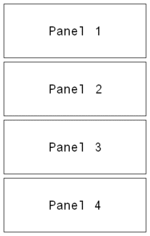Loading AI tools
Comic strip format From Wikipedia, the free encyclopedia
Yonkoma manga (4コマ漫画, "four cell manga" or 4-koma for short) is a comic strip format that generally consists of gag comic strips within four panels of equal size ordered from top to bottom. They also sometimes run right-to-left horizontally or use a hybrid 2×2 style, depending on the layout requirements of the publication in which they appear. Although the word yonkoma comes from Japanese, the style also exists outside Japan in other Asian countries as well as in the English-speaking market, particularly in mid-20th century United States strips, where Peanuts popularized the format.[1]

Rakuten Kitazawa (who wrote under the name Yasuji Kitazawa) produced the first yonkoma in 1902. Entitled Jiji Manga, it was thought to have been influenced by the works of Frank Arthur Nankivell and of Frederick Burr Opper.[2]
Traditionally, yonkoma follow a structure known as kishōtenketsu. This word is a compound formed from the following Japanese kanji characters:
These comic strips appear in almost all types of publications in Japan, including manga magazines, graphic novels, the comics section of newspapers, game magazines, cooking magazines, and so forth. The plot often ends within the four panels; although some serial development may pass on to future installments, creating a more continuous story. Some yonkoma also tackle serious topics, though most do so with humor. Some manga occasionally use yonkoma, usually at the end of a chapter or bound volume, as a non-canon joke to complement the story.
Seamless Wikipedia browsing. On steroids.
Every time you click a link to Wikipedia, Wiktionary or Wikiquote in your browser's search results, it will show the modern Wikiwand interface.
Wikiwand extension is a five stars, simple, with minimum permission required to keep your browsing private, safe and transparent.